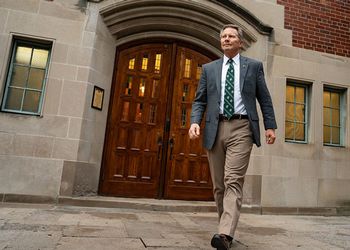President's Message: Powering a More Sustainable Tomorrow

It wasn’t so very long ago that smokestacks on the campus skyline were symbols of progress. They were a sign of self-sufficiency and, eventually, a source of nostalgia.
Today, Michigan State University is one of the nation’s top sustainable campuses, and Spartans view progress differently.
Earlier this year I had the pleasure of announcing the end of coal use at Michigan State. It’s an important step in our campus Energy Transition Plan, adopted in 2012, which will help MSU greatly reduce emissions and meet its future energy needs.
Meeting those needs—providing power for campus facilities and the students, faculty, and staff who use them every day—while reducing the negative impacts of power generation on our environment requires a long-term strategy, innovation, and commitment.
Each year as MSU advances its teaching and research capabilities, the physical landscape of campus transforms. When new and expanding facilities—like recent ones dedicated to biomedical and plant sciences, as well as the Facility for Rare Isotope Beams—come online they bring tremendous opportunities for creating a better world, but also increased energy demands.
In addition, in the past 30 years Michigan State’s enrollment has risen by just over a quarter to more than 50,500 students, and annual electrical demand has doubled to about 60,000 kilowatts. With multiplying classroom and office computers and personal electronic devices throughout campus, demand for electricity will continue to surge. At this rate, our energy demand will exceed our capacity to produce it on campus by 2020.
While we have worked aggressively to meet the goals of MSU’s Energy Transition Plan, the next phase will challenge us all and will require thinking about the ways we live and work today and tomorrow.
The plan calls for 20 percent use of renewable energy on the MSU campus by 2020, growing to 25 percent by 2025 and 40 percent by 2030. Some of the ways we’ll achieve those objectives include large-scale renewable energy projects and creating a system that connects energy and space costs and incentives to end users.
Meeting the energy generation and consumption challenges of the 21st century is critical to MSU’s mission on campus and beyond. Spartan researchers contribute much to innovation in energy technologies, from new kinds of solar cells and thermoelectric materials to biofuels and fuel cells to more energy-efficient auto engines. And in the fall, our students will have the opportunity to pursue a new minor in energy.
Renewing our commitment to campus sustainability and working as a community to meet our goals will help ensure a more sustainable tomorrow for all. Together, Spartans Will.



